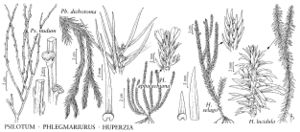Phlegmariurus
Preslia 36: 17, 21. 1964.
| Taxon | Illustrator ⠉ | |
|---|---|---|
 | Huperzia selago Huperzia lucidula Phlegmariurus dichotomus Psilotum nudum Huperzia appalachiana | John Myers John Myers John Myers John Myers John Myers |
Plants epiphytic or terrestrial, pendent [erect]. Roots produced in distal parts of shoots, migrating downward in cortex to emerge in substrate. Horizontal stems absent [present]. Shoots clustered, round in cross-section, dichotomously branching, 1.5–5 mm diam. Leaves not in distinct ranks [ranked], imbricate or not, monomorphic (or sporophylls sometimes differentiated), appressed, ascending to spreading, linear to subulate, margins mostly entire [denticulate]. Gemmiferous branchlets and gemmae absent. Sporangia reniform, borne individually in axils of undifferentiated or slightly differentiated sporophylls [differentiated sporophylls in strobili]. Spores pitted to small-grooved, sides at equator convex and angles acute. Gametophytes nonphotosynthetic, mycorrhizal, mainly growing buried in humus on trees, branched, paraphysate with uniseriate hairs; ring meristem absent. x = 68.
Distribution
in tropical areas worldwide
Discussion
As construed here, Phlegmariurus is very large and diverse. Many groups have been tentatively suggested in this genus (B. Øllgaard 1987). Some of these ultimately may be recognized as subgenera or even genera.
Species over 300 (1 in the flora).
Selected References
None.